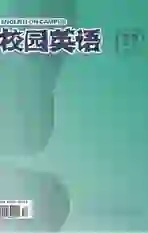A Foregrounding Analysis of E. E. Cumming’s “Buffalo Bill’s”
2020-08-02兰琪
【Abstract】E. E. Cummingswas the representative of American modern experimental poets. This paper aims at showing how Cummings uses all types of foregrounding to elevate the theme of his poem “Buffalo Bill s”. Linguistic features of the poem are studied from the stylistic levels. The analysis is done under the aspects of deviations at orthographic, graphological, lexical and grammatical level.
【Key words】stylistic; poetry; foregrounding; deviation
【作者簡介】兰琪,首都师范大学。
1. Theoretical Background Foregrounding
The technique of art is to make objects unfamiliar, to make forms difficult, to increase the difficulty and length of perception because the purpose of perception is an aesthetic end in itself and must be prolonged(Shklovsky 12).Then it is further discussed byJan Mukarovsky. He claims that foregrounding is the opposite of automatization, that is, the de-automatization of an act; the more an act is automatized, the less it is consciously executed; the more it is foregrounded, the more completely conscious does it become(Mukarovsky43).Foregrounding comes in two main guises: foregrounding as deviation from a norm and foregrounding as more of the same (Simpson50). Leech divides deviation into different types and the most important ones are: lexical, grammatical, phonological, and graphological deviation.
2. Analysis of the Poem “Buffalo Bill s”
This poem has its own unique phonological rhythm. Vowels and diphthongs in the first five linescreate a grieved atmosphere. Then, readers are forced to read a series of words in one breath. The quickening pace represents the tension between human and nature. Monosyllable words inthe last reveals the satire on heroism.Not only did E.E. Cummings use free verse, he introduced a highly visual style to his poetry. The pattern made by the end of the lines looks like a sideways mountain which implies that death is like a return to birth. Short lines at the beginning represent his youth. The lines that stretch all the way to the right represent the peak of his life, followed by the short lines against the left to represent his death.Besides, the poet omits the spaces among wordsand he makes them as one body: onetwothreefourfive and pigeonsjustlike. The lack of space gives the effect of swiftness as the words uttered, which seems the speed of gun shoot. Successive numbers refer to his achievements while he was alive. These two wordsgive us the impression that pigeons are inanimate andBuffalo Bill is so-called heroism. The another graphological deviation is the capitalization. The poet neglects the capitalization for the first letters in the beginning words of lines, even for the word “I”. Hence, all the lower-case letters are the background of capitalized words: Buffalo Bill, Jesus, and Mister Death. The poet satirizes Buffalo Bill by regarding him as the same level with Jesus and Mister.
Chomsky claims that the general norm in English is manifested through the rules of selectional restriction as described in transformational generative grammar.However, the two words “defunct” and “break” violate the rules. “Defunct” means something has stopped functioning. Cummings has implied it for the death of a “hero”, showing the indifferent attitude towards Buffalo Bill.He also uses “break” rather than kill to make the pigeons materialized. From these two words, we can see the man and pigeons are all materialized in front of death.
3. Conclusion
This poem is not a glorified tribute to Buffalo Bill Cody. The heros eulogy is to express the simple truth that all creatures are equal in front of death.The poet criticizes the hero who killed the animals ruthlessly as well as manifests“the irony of fate”, hero is helpless in front of death. It conveys that heroism has died with the hero, even more ironically that death didnt spare him.
References:
[1]Leech, Geoffrey. A Linguistic Guide to English Poetry[J]. London: Longman, 1969.
[2]Mukarovsky, J. “Standard language and poetic language”, in Freeman, D. C. (ed.) Linguistics and Literary Style[J]. New York: Holt, Rinehart and Winston, (1932, 1964, 1970):40-56.
